美英报刊阅读教程Lesson 34 课文
- 格式:doc
- 大小:32.00 KB
- 文档页数:3
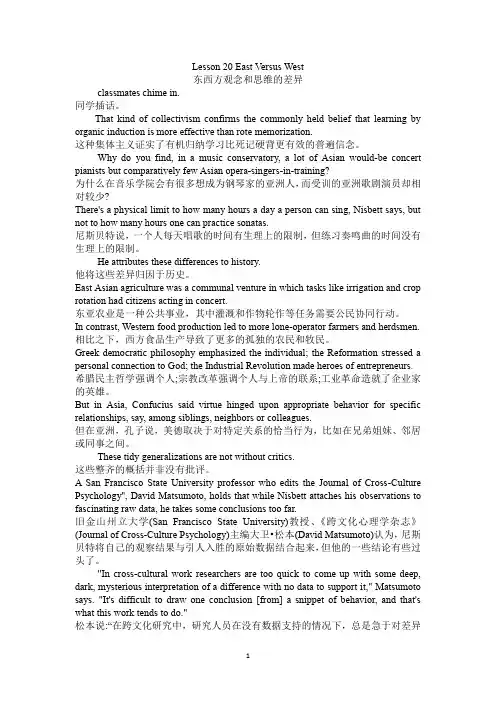
Lesson 20 East Versus West东西方观念和思维的差异classmates chime in.同学插话。
That kind of collectivism confirms the commonly held belief that learning by organic induction is more effective than rote memorization.这种集体主义证实了有机归纳学习比死记硬背更有效的普遍信念。
Why do you find, in a music conservatory, a lot of Asian would-be concert pianists but comparatively few Asian opera-singers-in-training?为什么在音乐学院会有很多想成为钢琴家的亚洲人,而受训的亚洲歌剧演员却相对较少?There's a physical limit to how many hours a day a person can sing, Nisbett says, but not to how many hours one can practice sonatas.尼斯贝特说,一个人每天唱歌的时间有生理上的限制,但练习奏鸣曲的时间没有生理上的限制。
He attributes these differences to history.他将这些差异归因于历史。
East Asian agriculture was a communal venture in which tasks like irrigation and crop rotation had citizens acting in concert.东亚农业是一种公共事业,其中灌溉和作物轮作等任务需要公民协同行动。
In contrast, Western food production led to more lone-operator farmers and herdsmen. 相比之下,西方食品生产导致了更多的孤独的农民和牧民。
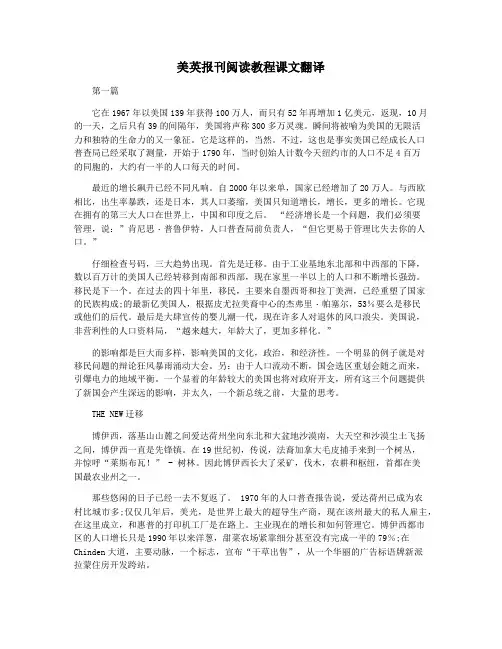
美英报刊阅读教程课文翻译第一篇它在1967年以美国139年获得100万人,而只有52年再增加1亿美元,返现,10月的一天,之后只有39的间隔年,美国将声称300多万灵魂。
瞬间将被喻为美国的无限活力和独特的生命力的又一象征。
它是这样的,当然。
不过,这也是事实美国已经成长人口普查局已经采取了测量,开始于1790年,当时创始人计数今天纽约市的人口不足4百万的同胞的,大约有一半的人口每天的时间。
最近的增长飙升已经不同凡响。
自2000年以来单,国家已经增加了20万人。
与西欧相比,出生率暴跌,还是日本,其人口萎缩,美国只知道增长,增长,更多的增长。
它现在拥有的第三大人口在世界上,中国和印度之后。
“经济增长是一个问题,我们必须要管理,说:”肯尼思・普鲁伊特,人口普查局前负责人,“但它更易于管理比失去你的人口。
”仔细检查号码,三大趋势出现。
首先是迁移。
由于工业基地东北部和中西部的下降,数以百万计的美国人已经转移到南部和西部,现在家里一半以上的人口和不断增长强劲。
移民是下一个。
在过去的四十年里,移民,主要来自墨西哥和拉丁美洲,已经重塑了国家的民族构成;的最新亿美国人,根据皮尤拉美裔中心的杰弗里・帕塞尔,53%要么是移民或他们的后代。
最后是大肆宣传的婴儿潮一代,现在许多人对退休的风口浪尖。
美国说,非营利性的人口资料局,“越来越大,年龄大了,更加多样化。
”的影响都是巨大而多样,影响美国的文化,政治,和经济性。
一个明显的例子就是对移民问题的辩论狂风暴雨涌动大会。
另:由于人口流动不断,国会选区重划会随之而来,引爆电力的地域平衡。
一个显着的年龄较大的美国也将对政府开支,所有这三个问题提供了新国会产生深远的影响,并太久,一个新总统之前,大量的思考。
THE NEW迁移博伊西,落基山山麓之间爱达荷州坐向东北和大盆地沙漠南,大天空和沙漠尘土飞扬之间,博伊西一直是先锋镇。
在19世纪初,传说,法裔加拿大毛皮捕手来到一个树丛,并惊呼“莱斯布瓦!” - 树林。
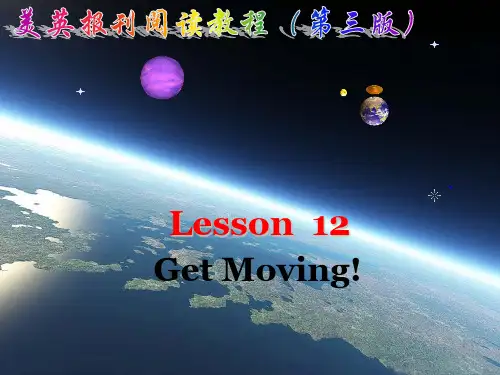
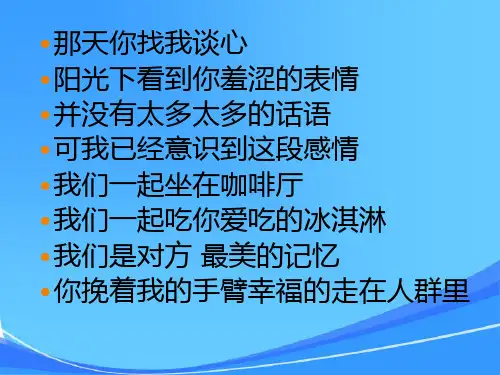
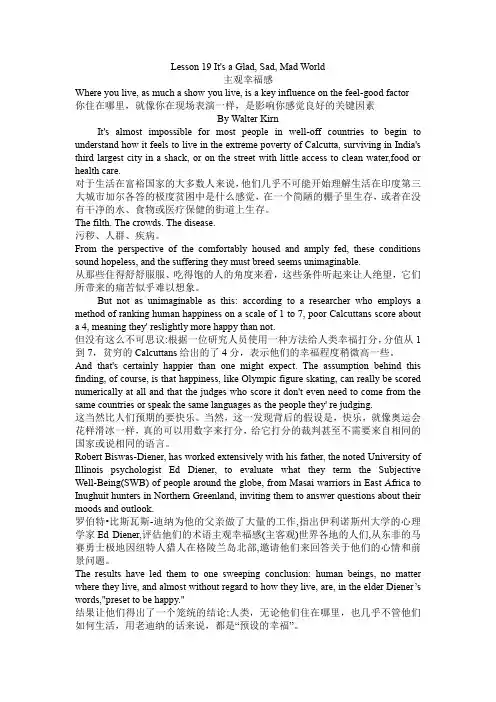
Lesson 19 It's a Glad, Sad, Mad World主观幸福感Where you live, as much a show you live, is a key influence on the feel-good factor你住在哪里,就像你在现场表演一样,是影响你感觉良好的关键因素By Walter KirnIt's almost impossible for most people in well-off countries to begin to understand how it feels to live in the extreme poverty of Calcutta, surviving in India's third largest city in a shack, or on the street with little access to clean water,food or health care.对于生活在富裕国家的大多数人来说,他们几乎不可能开始理解生活在印度第三大城市加尔各答的极度贫困中是什么感觉,在一个简陋的棚子里生存,或者在没有干净的水、食物或医疗保健的街道上生存。
The filth. The crowds. The disease.污秽、人群、疾病。
From the perspective of the comfortably housed and amply fed, these conditions sound hopeless, and the suffering they must breed seems unimaginable.从那些住得舒舒服服、吃得饱的人的角度来看,这些条件听起来让人绝望,它们所带来的痛苦似乎难以想象。
But not as unimaginable as this: according to a researcher who employs a method of ranking human happiness on a scale of 1 to 7, poor Calcuttans score about a 4, meaning they' reslightly more happy than not.但没有这么不可思议:根据一位研究人员使用一种方法给人类幸福打分,分值从1到7,贫穷的Calcuttans给出的了4分,表示他们的幸福程度稍微高一些。
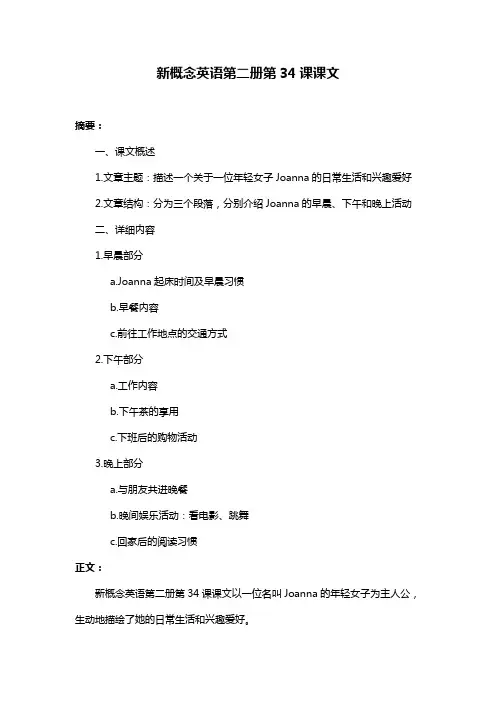
新概念英语第二册第34课课文
摘要:
一、课文概述
1.文章主题:描述一个关于一位年轻女子Joanna的日常生活和兴趣爱好
2.文章结构:分为三个段落,分别介绍Joanna的早晨、下午和晚上活动
二、详细内容
1.早晨部分
a.Joanna起床时间及早晨习惯
b.早餐内容
c.前往工作地点的交通方式
2.下午部分
a.工作内容
b.下午茶的享用
c.下班后的购物活动
3.晚上部分
a.与朋友共进晚餐
b.晚间娱乐活动:看电影、跳舞
c.回家后的阅读习惯
正文:
新概念英语第二册第34课课文以一位名叫Joanna的年轻女子为主人公,生动地描绘了她的日常生活和兴趣爱好。
在早晨,Joanna会在7:30起床,然后进行简单的晨练,如做一些伸展运动。
接着,她会为自己准备一顿丰盛的早餐,包括牛奶、麦片、水果和面包。
之后,她乘坐公共汽车前往工作地点。
在下午,Joanna会开始她忙碌的工作,这包括处理文件、接听电话以及与同事讨论项目。
下午茶时间,她会品尝美味的蛋糕和红茶,以此放松自己。
下班后,Joanna喜欢去商场购物,为自己添置一些衣物和日用品。
晚上,Joanna有时会与朋友共进晚餐,谈论彼此的近况。
之后,她们可能会去看一场电影,或者去舞厅跳舞。
尽情娱乐之后,Joanna会在晚上10:30左右回到家中,在睡前进行一段阅读,以此结束她充实的一天。
这篇课文通过描述Joanna的日常生活,向我们展示了她健康、充实的生活方式。

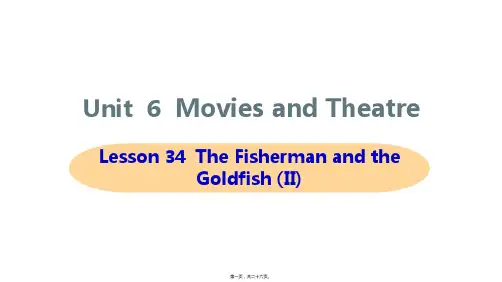
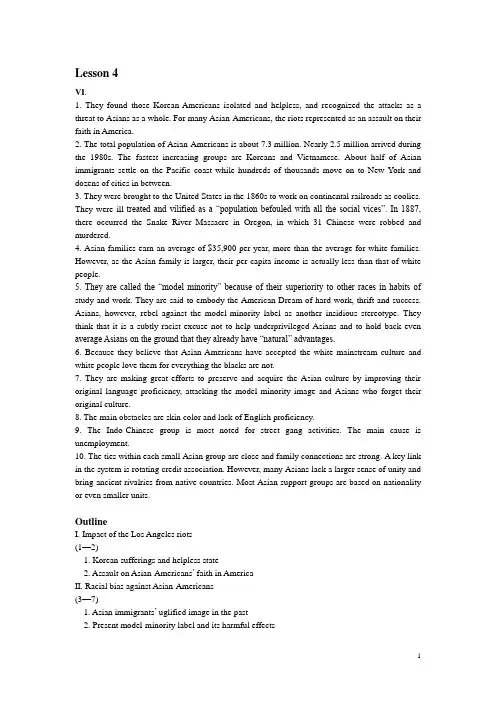
Lesson 4VI.1. They found those Korean-Americans isolated and helpless, and recognized the attacks as a threat to Asians as a whole. For many Asian-Americans, the riots represented as an assault on their faith in America.2. The total population of Asian-Americans is about 7.3 million. Nearly 2.5 million arrived during the 1980s. The fastest increasing groups are Koreans and Vietnamese. About half of Asian immigrants settle on the Pacific coast while hundreds of thousands move on to New York and dozens of cities in between.3. They were brought to the United States in the 1860s to work on continental railroads as coolies. They were ill-treated and vilified as a “population befouled with all the social vices”. In 1887, there occurred the Snake River Massacre in Oregon, in which 31 Chinese were robbed and murdered.4. Asian families earn an average of $35,900 per year, more than the average for white families. However, as the Asian family is larger, their per capita income is actually less than that of white people.5. They are called the “model minority” because of their superiority to other races in habits of study and work. They are said to embody the American Dream of hard work, thrift and success. Asians, however, rebel against the model-minority label as another insidious stereotype. They think that it is a subtly racist excuse not to help underprivileged Asians and to hold back even average Asians on the ground that they already have “natural” advantages.6. Because they believe that Asian-Americans have accepted the white mainstream culture and white people love them for everything the blacks are not.7. They are making great efforts to preserve and acquire the Asian culture by improving their original language proficiency, attacking the model minority image and Asians who forget their original culture.8. The main obstacles are skin color and lack of English proficiency.9. The Indo-Chinese group is most noted for street gang activities. The main cause is unemployment.10. The ties within each small Asian group are close and family connections are strong. A key link in the system is rotating credit association. However, many Asians lack a larger sense of unity and bring ancient rivalries from native countries. Most Asian support groups are based on nationality or even smaller units.OutlineI. Impact of the Los Angeles riots(1—2)1. Korean sufferings and helpless state2. Assault on Asian-Americans’ faith in AmericaII. Racial bias against Asian-Americans(3—7)1. Asian immigrants’ uglified image in the past2. Present model-minority label and its harmful effects3. Resentment against Asians for their success and behavior4. Asians’ isolation from the rest of the society5. Boycotts and assaults on Asian businessesIII. American culture’s influence(8—12)1. Fast increase of Asian immigrants wishing to realize the American Dream2. Second generation’s tendency to abandon Asian values3. Identity crisis resulting from two cultures’ pull4. Young people’s efforts to preserve the original culture5. The least assimilated group: Chinatown residentsIV. Discrimination against Asians(13—17)1. Hurdles for assimilation2. Glass ceiling3. UnemploymentV. Similarities and differences between Asians and Blacks(18—21)1. Similar sufferings2. Similar spiritualities3. Asian-Americans’ less difficulty in shrugging off the legacy of discrimination4. First-generation Asian immigrants’ incredibly hardworking and thrifty characterVI. Asians’ ties and political status(22—24)1. Close community ties2. Lack of a larger sense of unity3. Underrepresentation at all government levelsVII. Author’s view concerning the development of Asians’ sentiment(25) Unlikely to become a wider political movementLesson 6Answers to the QuestionsV. 1. B 2. B 3. B 4. C 5. DVI.1. Because they regard First Amendment freedom as essential American rights and will not allow any restriction on it.2. Because it holds the view that the reform will place restriction on individual rights and therefore should be fiercely resisted.3. Because the situation is not the same as before. In the 1950s, McCarthy and his inquisitors trampled the free expression of left-wing view; and so for the next two decades or so it was essential to defend the principle of free speech at every opportunity. Now the free speech is not in jeopardy, it should not be rigidly defended.4. Mr. Neuborne holds that in modern political campaign rich candidates flood voters with commercials and propaganda of every kind, so that others have no chance of attracting attention. Poor candidates may enjoy the right to speak, but not the hope that everyone will hear what theyhave to say. To give them a hearing, he suggests that the speech of rich candidates be limited.5. The authors mean that the situation now is different from that of the 1960s. Americans should not abide by the same principle in spite of the change of time. In the 1960s heyday, the ACLU was absolutely correct in upholding citizens’ rights against the police and other authorities. This was because they did not reflect the inte rests of America’s black minority. However, all that has now changed: many policemen, and police chiefs, are black, as are many mayors. If these leaders, reflecting the wishes of their constituencies, choose to adopt tough measures to fight crime, the ACLU should not presume to second-guess them. It’s time to adopt a different attitude.6. The ACLU’s rigid defence of rights ends up favoring the strong more than the weak.7. He thinks that America’s free speech has a price. Though America has been one of the freest countries in the world, it is one of those in which the gap between the rich and poor is the starkest.OutlineI. The burial of the campaign finance reform and its implications(1)II. Two sides’ views on the reform(2)1. Opponents’ view2. Majority’s viewIII. American public’s qualified support for free speech(3—5)1. Firm belief in the first amendment2. Strong support for the campaign finance reform3. Deep split within the ACLU over the campaign financeIV. Criticism of the ACLU’s rigid defence of rights(6—11)1. Burt Neuborne’s view on the ACLU’s line on campaign spending2. Tracey Meares and Dan Kahan’s criticism of the ACLU’s other issuesV. Author’s comment(12) Liberty has a price.Lesson 7Answers to the QuestionsV. 1. D 2. C 3. D 4. D 5. BVI.1. It indicates that Microsoft corp. has tight control over the software business.2. The present honeymoon will not last long. The industry does not speak with one voice. At the same time, their success has greatly damaged the interests of other industries. So there will be troubles ahead. Besides this, there’s also potential for a huge culture clash. A lot of Silicon Valley types don’t realize the importance of politics and have disdain for government.3. President Clinton promised to keep the Internet tax-free for now and Hewlett Packard Co. won approval to export sophisticated cryptography chips. The 1986 semiconductor trade agreement was signed to stop the dumping of Japanese chips in the US and set market-share goals for US chips in Japan.4. The industry believes that government should do what it needs to do but leave them alone. The software tycoons have little patience for bureaucratic oversight and tend to be uncompromising. The hardware tycoons are willing to look for compromise.5. They are: easing immigration restriction; securities-litigation reform and ending export limit of encryption technology.6. The Internet and electronic commerce have been rearranging the business landscape—changing how Americans buy everything. They are spreading into all sorts of digital services, from entertainment to online banking to telephony.7. Because high-tech leaders have realized that the industry’s future is less about technology and more about policy.OutlineI. Close contact between high tech industry and Washington politicians(1—2)1. Specific example: Bill Gates and Scott G. McNealy’s attendance at the March 3 hearing of the Senate Judiciary Committee2. Increasing contact between high tech industry and Washington policy makersII. Reasons for the close relationship(3—6)1. High tech industry’s fast expansion and the appearance of more issues2. Politicians’ strong interest in the job growth industry3. Increasing conflicts between high tech industry and other industries4. High tech industry’s urgent need for solution to many problemsIII. Relationship between high tech industry and government(7—11)1. Good relationship at present2. Difficulties in maintaining the honeymoon3. Need for high tech new executives to learn lobbyingIV. Efforts made by high tech companies at lobbying(12—14)1. Computer companies’ fight for a high-definition TV format2. The establishment of Washington offices3. Crusade to fight alleged Japanese dumping of computer chipsV. Problems with the high tech industry(15—16)1. Lack of unity2. Little patience for bureaucratic oversightVI. Objectives of the high tech executives(17—18)1. Easing immigration restriction and securities litigation reform2. Ending limit on the export encryption technologyVII. Prospects(19) High tech executives will quickly learn how to play the Washington political gameLesson 12Answers to the QuestionsV. 1. A 2. D 3. D 4. C 5. BVI.1. The market situation of the sales in the United States is much better than ever before. Many bookstores report increases of over 30%.2. America’s bookstores offer a rich diversity of Bibles to suit people’s different needs and comprehension levels. The 270 stores in the Family Christian Stores chain might carry 200 different titles. Customers now have more choices in format, bindings, boxing and pricing. All new Bibles claim improved scholarship, better readability and more relevance.3. The advance of technology has made it possible to publish more quickly and less expensively. Therefore, it has helped to speeden new Bible production and shorten the shelf life of Bibles.4. In order to meet readers’ different needs, publishers produce specialty Bibles and Bibles with notes and comments.5. The initialism NIV stands for the New International Version.6. The notes and comments in the new Bible would produce the adverse effects of leading the reader off the right page theologically and remaking God in the writer’s own image.OutlineI. Fast increase of Bible sales(1—5)II. Rich diversity of Bible versions and variations(6—17)1. More choices in bindings, boxings and pricing2. Different kinds of Bibles serving different purposes3. Different Bibles claiming improved scholarship and readability4. An explosion of format choicesIII. Reasons for the rich diversity(18—25)1. Advance of technology2. Bible companies’ desire for their market shares3. Customers’ wish for specialty versions suiting their specific needsIV. Possible adverse effects of the notes and comments(26—35)1. Leading the reader off the right page theologically2. Remarking God in one’s own imageLesson 15Answers to the QuestionsV. 1. B 2. D 3. B 4. B 5. AVI.1. Americans transfer less money among themselves for such things as social security and welfare.2. It is the measure of “fiscal drag”—the burden taxes place upon an economy.3. It refers to funds that go from one citizen’s pocket to another’s with the government as intermediary.4. High-tax, high-transfer countries tend to be culturally cohesive. America is a melting pot. It is a more diverse society. People are reluctant to contribute to the public spending.5. Lower taxes. More services and more spending.6. They would shoulder higher taxes if they could be sure that doing so would make life better for themselves, their children and their children’s children. A great ma jority would pay more if they could be guaranteed the money would go to education or health insurance or even housing for the homeless. They are willing to pay for the direct and visible services.OutlineI. American’s tax load compared with people of other countries(1—3)1. Lighter load according to OECD’s finding2. More complaints about taxes according to opinion polls3. Author’s view on OECD’s findingII. Similarities and differences between America and other countries in taxes(4—9)1. Similaritya. Allocation of similar proportion of GDP to governmentb. Effect of the allocation on economy: fiscal dragc. US tax payers’ strong sense of fiscal drag2. Difference: US less transfer paymentsa. America’s capability to increase transfer paymentsb. Reasons for US less transfer paymentsUS less cultural cohesion caused by the society’s diversity;Government’s less spending for infrastructureIII. Public’s sentiment over taxes(10—12)1. Willingness to pay more for worthwhile causes such as education and pollution control2. Hatred for bureaucrats’ waste of taxpayers’ money3. Tendency to want it both ways: lower taxes, but more servicesResult: huge federal deficitLesson 17Answers to the QuestionsV. 1. C 2. D 3. C 4. D 5. DVI.1. Alcohol poisoning caused Wynne’s death. The autopsy of Wynne found that he had a blood alcohol level six times the amount at which the state considers a person intoxicated.2. Excessive drinking among college students has been blamed for at least six deaths in the year before the writing of the article. It affects not only the bingers but also fellow students, who are more likely to report lost sleep, interrupted studies and sexual assaults on campuses with high binge-drinking rates. Sometimes it may cause riots.3. The most important factor is the campus culture encouraging students to drink, and drink heavily. At many colleges, school life is still synonymous with alcohol-lubricated gatherings. College newspapers are filled with alcohol-related ads. On many campuses, bars send shuttle buses to round up students.4. The act of raising the legal drinking age from 18 to 21 can not solve the problem. Many drink at private parties off campus, with an older student buying the alcohol. Bars’enforcement of the drinking age is often lax, false IDs are common, and legal-age friends are often willing to buy the drinks and bring them back to the table. Instead of drinking in well-monitored settings, the young often experiment in private homes and bars, where there are few checks in place to deter dangerous practices. Research suggests that making alcohol illegal may give it an illicit thrill for younger drinkers. So raising the age may have made the binge problem even worse.5. To solve the binge problem, many colleges hand out literature and hold workshops to educate students about responsible drinking. In addition, they penalize campus groups that sponsor reckless parties.6. No, it’s far from enough just to ban alcohol on campus, for it does nothing about the excessive drinking off-campus. So, colleges should work with the larger community to ensure that students cannot abuse alcohol at private homes and bars.OutlineI. Specific example: Wynne’s death of alcohol poisoning(1)II. General situation: Pervasive binge drinking on campuses(2—3)1. A common problem with most schools2. Huge yearly consumption of alcohol3. Harmful effects on the bingers and fellow studentsIII. Causes for the campus binge problem(4—5)1. Binge-encouraging culture: alcohol-lubricated gatherings; college newspapers’advertising; bars’ shuttle-bus service2. Off-campus wide-availability and high promotion of alcoholIV. Measures taken by many colleges to solve the binge problem(6—7)1. Education through literature and workshops2. Punishment for campus groups for sponsoring reckless parties3. Ban on alcohol consumption on campusesV. Author’s recommended measures(8—9)1. Working with the larger community to stop off-campus alcohol abuse2. Encouraging on-campus responsible drinking for those of legal drinking ageLesson21Answers to the QuestionsV. 1. B 2. C 3. D 4. A 5. BVI.1. He took two of his father’s guns from an unlocked cabinet and a third from a family car. He had learnt to fire weapons from his father.2. He means that Barry Loukaitis’ shooting in many respects showed the way in which America’s school yard killings would occur. More recent school killings followed the pattern of Barry Loukaitis’ shooting.3. The violent pop culture predisposed kids to violent behavior. It produced a profound cultural influence pulling kids into a world where violence is a perfectly normal way to handle emotions.4. It shows a very serious problem: American juveniles are becoming violent, callous andremorseless. More kids have mental disorders and their mental problems occur earlier.5. Most earlier killings were gang-related, or they were stabbings involving money or a girl friend. However, most recent killings were shootings done by kids with mental troubles. The victims were chosen at random.6. Yes, they gave ample warning signs, often in detailed writings at school, of dramatic violent outbursts to come. However, adults never took the threats and warning signs seriously. They simply overlooked them.7. Juvenile suicide rates have increased over the last four decades and have leveled off near their all-time highs. More than 1.5 million Americans under age 15 are seriously depressed.8. Because they were strapped for mental health counselors.9. Their parents or grandparents did not lock guns out of kids’ reach. Some of them even bought them guns and taught them how to use the guns.OutlineI. Specific example: Barry Loukaitis’ shooting on Feb. 2, 1996(1—4)II. Common traits of school yard killings after Barry’s shooting(5—14)1. Mental state: displaying problems2. Instruments for killing: easy access to guns3. Culture’s influence: immersion in gun culture and obsession with violent pop culture4. Signs of violence: showing ample signs, which, however, are overlookedIII. Striking changes of school yard killings in type over the last six years(15—27)1. Most earlier killings: gang-related stabbings; fights over money or a girl friend2. Most killings after Barry’s shooting: use of guns; random choices of victims; mental troubles3. Examples: Barry Loukaitis; an Alaskan boy; Luke Woodham in Mississippi; Michael Carneal in Kentucky; a 13-year-old boy in ArkansasIV. Analysis of the Causes(28—41)1. Mood disorders happening earlier & shortage of mental health counselors2. Easy access to guns: unlocked; parents’ teaching; holiday gifts; taking courses3. Pop culture’s influence: violent video shows and video games; gangster rap。

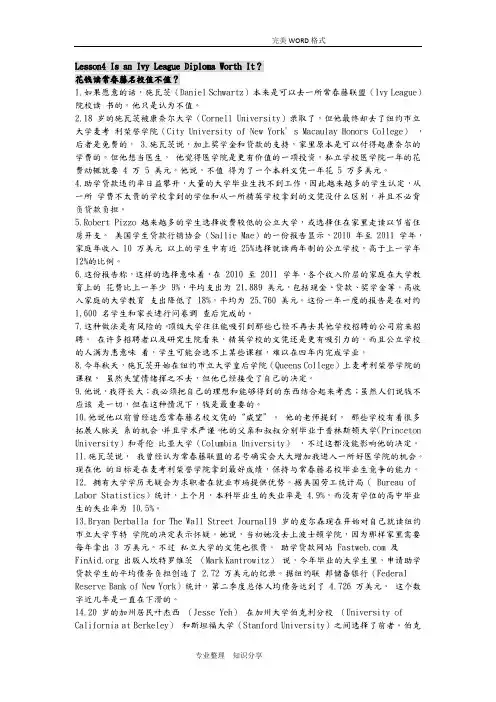
Lesson4 Is an Ivy League Diploma Worth It?花钱读常春藤名校值不值?1.如果愿意的话,施瓦茨(Daniel Schwartz)本来是可以去一所常春藤联盟(Ivy League)院校读书的。
他只是认为不值。
2.18 岁的施瓦茨被康奈尔大学(Cornell University)录取了,但他最终却去了纽约市立大学麦考利荣誉学院(City University of New York’s Macaulay Honors College),后者是免费的。
3.施瓦茨说,加上奖学金和贷款的支持,家里原本是可以付得起康奈尔的学费的。
但他想当医生,他觉得医学院是更有价值的一项投资。
私立学校医学院一年的花费动辄就要 4 万 5 美元。
他说,不值得为了一个本科文凭一年花 5 万多美元。
4.助学贷款违约率日益攀升,大量的大学毕业生找不到工作,因此越来越多的学生认定,从一所学费不太贵的学校拿到的学位和从一所精英学校拿到的文凭没什么区别,并且不必背负贷款负担。
5.Robert Pizzo 越来越多的学生选择收费较低的公立大学,或选择住在家里走读以节省住房开支。
美国学生贷款行销协会(Sallie Mae)的一份报告显示,2010 年至 2011 学年,家庭年收入 10 万美元以上的学生中有近 25%选择就读两年制的公立学校,高于上一学年12%的比例。
6.这份报告称,这样的选择意味着,在 2010 至 2011 学年,各个收入阶层的家庭在大学教育上的花费比上一年少 9%,平均支出为 21,889 美元,包括现金、贷款、奖学金等。
高收入家庭的大学教育支出降低了 18%,平均为 25,760 美元。
这份一年一度的报告是在对约1,600 名学生和家长进行问卷调查后完成的。
7.这种做法是有风险的。
顶级大学往往能吸引到那些已经不再去其他学校招聘的公司前来招聘。
在许多招聘者以及研究生院看来,精英学校的文凭还是更有吸引力的。
美英报刊文章阅读lesson9摘要:一、文章概述1.文章主题:介绍美英报刊文章阅读课程第九课的内容。
2.课程目标:帮助学生提高阅读理解能力,扩展知识面。
3.适用人群:有一定英语基础的学习者。
二、课程内容1.课程背景与目标a.课程意义:提高学生阅读理解能力,培养独立思考。
b.课程目标:学习者能阅读并理解美英报刊文章,掌握文章主旨和细节。
2.课程安排与要求a.课程设置:阅读材料、词汇、语法、讨论和作业。
b.学习要求:积极参与课堂讨论,完成课后作业。
3.课程特色与优势a.结合时事:选用热点话题文章,提高学习者兴趣。
b.实用技巧:教授阅读策略,提高阅读效率。
c.互动学习:鼓励学生提问和分享观点,培养批判性思维。
三、课程收获与评价1.学习者收获a.阅读能力:提高阅读速度和理解力。
b.知识面:了解美英报刊文章中的热点话题。
c.思考能力:学会独立思考和表达观点。
2.课程评价a.教学方法:采用生动有趣的教学方式,激发学习兴趣。
b.教学质量:教师经验丰富,课程质量高。
正文:美英报刊文章阅读课程第九课旨在帮助学生提高阅读理解能力,扩展知识面。
本课程适用于有一定英语基础的学习者。
在课程中,我们首先介绍了课程背景与目标。
课程意义在于提高学生的阅读理解能力,培养他们独立思考的能力。
课程目标则是使学习者能阅读并理解美英报刊文章,掌握文章的主旨和细节。
接下来,我们详细介绍了课程安排与要求。
课程设置包括阅读材料、词汇、语法、讨论和作业。
在学习过程中,要求学习者积极参与课堂讨论,完成课后作业。
此外,本课程还具有以下特色与优势:结合时事,我们选用热点话题的文章,以提高学习者的兴趣;教授实用的阅读策略,以提高阅读效率;鼓励学生提问和分享观点,以培养他们的批判性思维。
通过学习本课程,学习者可以收获阅读能力的提升、知识面的扩展以及思考能力的培养。
课程得到了广泛的好评,教学方法生动有趣,激发了学习者的兴趣,而教师丰富的经验保证了课程的高质量。
课⽂翻译英美报刊阅读教程中级精选本第五版端⽊义万Lesson18Lesson 18 Those Rugged Individuals美国个体主义价值观No ideal may be held more sacred in America, or be more coveted by others, than the principle of individual freedom.在美国,没有什么理想⽐个⼈⾃由原则更神圣,也没有什么理想⽐个⼈⾃由原则更令⼈垂涎。
Given the chance to pursue the heart's desires, our Utopian vision claims, each of us has the ability and the right to make our dreams come true.我们乌托邦式的愿景宣称,只要有机会去追求内⼼的渴望,我们每个⼈都有能⼒和权利去实现⾃⼰的梦想。
This extraordinary individualism has prevailed as the core doctrine of the New World through four centuries, bringing with it an unrelenting pressure to prove one's self.四个世纪以来,这种⾮凡的个⼈主义⼀直是新世界的核⼼信条,随之⽽来的是证明⾃我的⽆情压⼒。
The self-made man has been America's durable icon, whether personified by the prairie homesteader or the high-tech entrepreneur.'⽩⼿起家的⼈是美国经久不衰的偶像,⽆论是草原上的农场主还是⾼科技企业家都是他们的化⾝。
Lesson 8 Our Love Affair with CarsThe automobile, marking 100 years as a major focal part of American life,takes its share of criticism. But it also has played a leading rolein shaping modern life with its many amenities.[1]By George F. Will1. It has changed how the landscape is experienced and how cities are shaped, hi it uncounted millions of marriages have been proposed and relationships consummated.[2] From courtship to crime to consumption, from the American economy to the American spirit, almost nothing would be as it is were it not for the handiest thing that ever happened for the hot pursuit of happiness.[3]So let us praise the automobile, born, sort of[4], 100 years ago.2. The auto industry’s centennial is being celebrated because in 1896 th e Duryea brothers of Springfield, Mass.[5], sold 13 cars. Critics, called “carrnudgeons,” who are legion and mostly liberals, ask, “What’s to celebrate?”[6]3. Yes, cars emit exhaust, and 1899 produced America’ s first recorded traffic fatality, the first of—so far—2.8 million deaths from traffic-related injuries. But horses were lethal, and stifle your nostalgia for those suffocating summers when windows were sealed, but noses were not, against billowing dust of finely ground manure produced by horses[7 ]such as those that deposited 60,000 gallons of urine on New York’ s streets every day.4. The mass production of automobiles on moving assembly lines, emulating the disassembly of cattle by meatpacking companies[8], increased productivity and wages, enabling workers to buy what they made. To facilitate purchases, automobile companies developed “installment buying,” and credit unions flourished facilitating it.[9] This destigmatized indebtedness, which government embraced with gusto, and increased Americans’ reluctance to defer gratifications.[10]5. Automobile and oil companies pioneered franchising for dealers of their products[11]. Credit cards were developed by oil companies to make credit portable. The democratized possession of machines capable of inflicting personal injuries and property damage enormously stimulated the insurance industry.[12] Supermarkets prospered because car owners could shop once a week. The automobile created vast wealth by increasing the value of land now accessible to people who worked in, but preferred not to live in cities.[13]6. Today, when most commutes are not from suburb to city but from one suburb to another, cars are blamed for suburbs, which are blamed for urban decline and desecration of the countryside.[14] Granted[15], suburbs sometimes are named for what their developers destroyed (“Forest View,” “Rolling Acres”[16]).7. The “getaway car” made criminals mobile and gave us movie car chases.[17] But liberals blame the automobile for myriad crimes, including Wai-Marts, “the mallification of America” and the breakdown of “community.”[18] Actually, automobiles were conquerors of rural loneliness, especially that of women, when farm families lived an average of five miles from market, six miles from school, 14 miles from a hospital.8. Automobiles were indispensable for the establishment in the 1950s of the teen-age nation-within-the-nation.[19] Before James Dean totaled his Porsche and himself at age 24, he was the archetypical teen-ager, a rebel without a cause but not without a car.[20 ]Automobiles solved what Frederick Lewis Allen called “the difficulty of finding a suitable locale formisconduct[21].” Hitherto, young swains had been confined to porch swings, with the girls’ parents and siblings underfoot.[22] Now they could drive away and, more to the point, park.9. GM’s “ladder of consumption”—Chevrolet, Pontiac, Oldsmobile, Buick, Cadillac—gave America an ersatz class structure, but one easy to climb.[23] Sure, ‘ 50s cars—from their protuberant, not to say nubile, front bumpers to their tail fins[24]—looked, as a wit said, “like chorus girls coming and fighter planes going.” And perhaps the “planned obsolescence”[25] of annual model changes was not entirely, as Detroit insisted, “healthy dissatisfaction.” Perhaps the tele vision program “My mother the Car” indicated that the tendency to anthropomorphize cars had gone a tad far.[26]10. Who cares. Forget the vulgarities, celebrate the virtues of automobility. An open road produces an open society. The automobile has been an emancipating device, celebrated in our literature, from “The Great Gatsby” to “On the Road.” Were Huck to light out for the territories today, he would go in a Ford Explorer.[27]11. “Mason City. To get there you follow Highway 58, going northeast out of t he city, and it is a good highway and new.” So begins “All the King’s Men.” In the land of the automobile, every man’s a king.From Pacific Stars and Stripes, July 2, 1996。
Lesson 34 Out of the BlueOn a picture-perfect Texas morning, the shuttle Columbia was heading home when tragedy struck, leaving America and the world wondering what went wrong-and honoring the lives of seven brave astronauts.By Evan Thomas1) Tony Beasley, an astronomer at the California Institute of Technology, got up early, along with his wife and mother-in-law, to watch the space shuttle fly overhead. It was a little after 5:45 a.m., California time, 7:45 a.m. at Mission Control1 in Houston, 8:45 a.m. at Cape Canaveral in Florida. Beasley could see the bright glow of the shuttle as it came over California’s Owens Valley, bound for a Florida landing, still 60 miles high, traveling at about 20 times the speed of sound. Then he noticed some bright flashes, just small ones at first. Beasley idly wondered if the shuttle was shedding some debris as it entered the atmosphere. He didn’t make much of it;2 he thought he recalled that space shuttles sometimes lost a few tiles as the craft burned into the atmospnere. But then he noticed a large pulse of light. “It was like a big flare being dropped from the shuttle,” he told Newsweek. “It didn’t seem normal.”2) A few minutes later, a few hundred miles to the east in Red Oak, Texas, Trudy Orton heard a boom as she stood on her front porch in the brightening morning. She thought it was a natural-gas explosion. “My house shook and windows rattled.” Her dog ran into the house and hid. A neighbor, loading her car, looked up and asked, “What on earth was that?” Orton lo oked up and saw a white streak of smoke across the sky. “It wasn’t a sleek little straight line like the jets make. It was billowing like a puffy cloud.”3) At the Kennedy Space Center at 9 a.m., ET, the festive crowd-NASA officials, family members of the astronauts, local dignitaries and politicians, even a representative of the Israeli government, on hand to honor Israel’ s first astronaut, Col. Ilan Ramon-eagerly listened for the familiar sonic boom, heralding the arrival of the returning shuttle. But as the skies remained silent, the burble of chatter died down, then grew anxious. At about 9:05, mobile phones began to ring. Suddenly, officials were herding family members into buses. The countdown clock continued to wind down to the scheduled 9:16 landing. But the crowd was already gone.4) The specialists inside Mission Control were well aware that the complex machines they put into space and then hope to bring home again are potential deathtraps. The rest of us forget, until a tragedy occurs, and the nation and the world are left mourning the loss of the astonishing array of hope and talent that routinely fly aboard the shuttles-113 trips, so far. When the shuttle Columbia disintegrated over Texas last Saturday morning, it took with it an Air Force colonel and test pilot3 (whose last job had been chief of safety for the astronaut office); a former Eagle Scout fighter jock4 (second in his class at Annapolis); a veteran African-American astronaut making his second trip into space; an India-born woman with a Ph.D. who enjoyed flying aerobatics5; a medical doctor who had performed in the circus as an acrobat; another medical doctor who was a mother, and an Israeli Air Force hero who had bombed Iraq’ s Osirak nuclear reactor in 1981.5) The seven crew members of the Columbia were finishing a 16-day mission that had gone off without a hitch6, hi between conducting dozens of scientific experiments, there had been plenty of time for stargazing. Astronaut Kalpana Chawla had told reporters how much, on a prior shuttle mission, she had enjoyed “watching the continents go by, the thunderstorms shimmering in theclouds, the city lights at night.” She flew over her native India and saw the Himalayas for the last time less than an hour before she died.6) By about 7 a.m. Eastern time, the astronauts had just about finished up the chore of checking the hundreds of switches in the crew module, verifying that they were in the right position for re-entry. In Florida, early-morning fog still shrouded the runway at Cape Canaveral, but NASA officials were confident the haze would burn off.7 The weather had been perfect for the launch; the forecast was blue skies at the landing.7) Launches are the most frightening part of space-flight. “On re-entry you have some elevated appreh ension, but nowhere near what you feel on launch,” says retired astronaut Mike Mullane. “Because you don’ t have any engines running, it’ s a much more passive event; you don’ t have the same threat of death hanging over you that you do on launch.” Even so, re-entry is perilous. Engineers talk about “the exchange of energy8.” The space shuttle stores up tremendous kinetic energy when it blasts off and circles the globe. It must dissipate that energy to slow down enough to return to Earth.In essence, speed is exchanged for heat. The orbiter begins to make sweeping S-rurns as it enters the Atmosphere. At the moment of maximum friction, the temperature around the orbiter is 3,000 degrees. To reflect the heat and protect its metal frame, the shuttle has about 20,000 hand-laid tiles on its nose and underside. These ceramic tiles are light-like a piece of Styrofoam-but they are rock-hard. As the shuttle enters the atmosphere, it must be at just the right attitude, or angle of attack. The nose is tilted up sharply.9 If the orbiter pitches forward or jerks sideways, the metal will start melting and the airframe will come apart.9) The Columbia’s two-minute, 38-second “de-orbit burn” -firing its rockets to brake (for) its initial descent-went off right on schedule at 8:15 a.m.,10 ET. At the tune, the shuttle was flying upside down and backward, its tail pointed in the direction of travel, some 175 miles above the Indian Ocean, just west of Australia. Its onboard computers began to swing the orbiter around into its nose-up position.” At 8:44 a.m., the orbiter began what is known as “entry interface.” The protective tiles on the belly glowed red-hot as the plane began to bounce off the upper fringes of the atmosphere.10) At 8:46 a.m., ET, the Columbia made landfall in California. This was just about the time when Tony Beasley and his wife began noticing odd things happening to the shuttle as it raced across the heavens. Inside the orbiter, and down at Mission Control, everything still seemed A-OK. The first sign that anything might be amiss did not come until 8:53. A sensor measuring temperatures on the left wing suddenly blinked out. By itself, this was not alarming. Sensors often cut out because of a minor malfunction.12 Mission Control did not even bother to inform the crew. Then at 8:56, the heat sensors in the left main tire well spiked up.13 A couple of minutes later, more sensors went out, this time in the body of the craft itself, along its left side. At 8:59, the temperature and tire-pressure gauges on the left side failed to register. By this time, Houston and the crew of Columbia were beginning to discuss the glitch. At 9 a.m., the Houston controller said, “Columbia, Houston, we see your tire-pressure messages and we did not copy your last.”11) Aboard the Co lumbia, the mission commander, Col. Rick Husband, said calmly, “Roger, buh…”12) Silence for several seconds.13) Then static and some clicking.14) By now Mission Control was getting anxious. In itself, the loss of communication was notentirely ominous. Spacecraft lose contact with ground control from time to time. But too many sensors-unconnected to any single source-were on the fritz. Chief flight director Milt Heflin later gloomily but laconically described the atmosphere in Mission Control: “The te am was beginning to know we had a bad day.”15) Some 200,000 feet above Texas, the astronauts were already dead, if they were lucky. When the space shuttle Challenger blew up in 1986, the command module survived the initial blast. The astronauts inside survived a gruesome two-minute, 45-second ride to a watery grave in the Atlantic. Traveling at 18 times the speed of sound, the command module14 of the Columbia may have blown apart, instantly killing the crew. But judging from the TV camera shots of the spacecraft as it came apart in the Texas sky, a large chunk-possibly the command module-stayed intact for many seconds.16) The debris of the Columbia landed in at least three states-Texas, Arkansas, and Louisiana- and possibly a couple more. On one Texas field, wisps of gray smoke rose from a huge patch of blackened grass. Nacogdoches County reported some 1,000 pieces of debris-twisted metal, evil-looking shards still steaming with highly toxic propellants15. There were tales of near misses- one piece suppos edly plunged into an empty dentist’ s chair-but no deaths or injuries were reported in the first few hours after the disaster.17) The second-guessing will start soon enough. By Saturday night, the whistle-blowers were already beginning to toot on the Internet and on the talking-head shows, claiming they had been predicting disaster for years.16 One San Diego professor held a press conference to assert that he had long raised alarms about the fragility of the tiles. Having been through the Challenger tragedy, NASA knows that the inquiries will be long and the scrutiny harsh. Indeed, NASA has already called for an independent commission.18) It is entirely possible that neither faulty heat tiles nor the insulation breaking over the wing on launch had anything to do with the tragedy.17 NASA officials are hoping that the disaster was what they call a “one-off’ – a one-time accident and not the result of some deeper structural flaw. The Challenger was brought down by faulty O-rings, a kind of giant plastic washer placed between the joints of the booster rocket.18 It took NASA two years to find and correct his structural flaw. No shuttle flew for 32 months.19) The shuttle program cannot afford the wait that long. Three of the loneliest members of the human race have to be the crew of the International Space Station. Navy Capt. Kenneth D. Bowersox, mission commander; Los Alamos scientist Donald Pettit, and flight engineer Russian cosmonaut Nikolai Budarin were expecting to be whisked back to Earth by the space shuttle Atlantis in March. With all shuttles grounded, they may be stranded. NASA says the space-station astronauts have enough food and provisions to hold out until June. But then they may have to climb into the Russian Soyuz19 “lifeboat” to make their esca pe, or possibly wait for the Russians to launch a rescue mission. Space is a perilous place. The fall of Columbia reminds us of those dangers-and of the bravery of the men and women who defy them.From Newsweek, February 10, 2003。